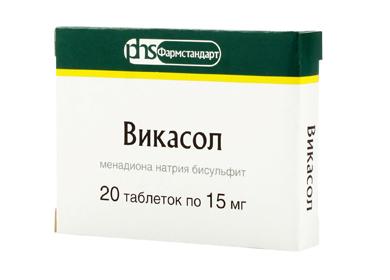The content of the article
The main active ingredient that is part of Vikasol is sodium menadione bisulfite. This medicine belongs to the group of antihemorrhagic drugs and is similar in structure to vitamin K. The latter is an extremely important substance that contributes to the formation of blood coagulation factors: VII, IX, X. The presence of these factors is necessary to trigger the formation of a fibrin clot. Vitamin K is involved in the conversion of prothrombin to thrombin, which affects the duration of bleeding.
Release Forms
Vikasol is available in two pharmaceutical forms.
- Pills. Contain 0.015 g of menadione sodium bisulfite. In addition, the composition of this dosage form includes excipients: sucrose, starch, calcium stearate and others.
- Ampoules. Injections contain 1 ml of a solution in which 0.01 g of menadione is located. This release form is intended for intramuscular administration only.
For a certain period of time, the active substance of the drug is in a bound state with plasma proteins. "Vikasol" penetrates well into almost all body tissues, especially high concentrations are found in the heart muscle, striated muscles, spleen, and liver. Most of this drug is excreted in the urine.
Indications
Indications for the use of "Vikasol" are any conditions associated with an increased risk of bleeding. Most often, the drug is recommended for the following pathologies:
- hemorrhages caused by insufficient intake of vitamin K into the body (with bowel diseases, severe liver pathologies);
- hemorrhagic diseases in newborns;
- bleeding caused by injuries or injuries;
- uterine bleeding against a disturbed menstrual cycle;
- heavy periods with myoma or beginning menopause;
- high risk of bleeding while taking anticoagulants;
- nosebleeds;
- bleeding from the gastrointestinal tract;
- bleeding with hemorrhoids.
Also, "Vikasol" is prescribed for the prevention of bleeding in the preoperative period or after the operation.
Dosage
Tablets are taken in between meals, drinking plenty of drinking water. In infants, the drug is administered parenterally.
The dosage of the drug is determined by the following table.
Table - Dosage of "Vikasol" by age
| Age | Daily dosage, mg |
|---|---|
| 0-1 year | 2-5 |
| 1-2 years | 6 |
| 3-4 years | 8 |
| 5-9 years old | 10 |
| 10-14 years old | 15 |
| Adults | 15-30 |
The maximum amount of medication that an adult patient can take at a time is 30 mg. No more than 60 mg of "Vikasol" is permissible per day, which are divided into two or three doses. (For newborns - no more than 4 mg).
In the treatment of heavy periods, the drug begins to be taken a few days before the expected date of menstruation. The total treatment time is three to four days.
Side effects
In general, the medicine is well tolerated by patients, but the following side effects are sometimes noted:
- disorders in the blood system (hemolytic type anemia, hemolysis in the presence of congenital fermentopathies);
- allergy in the form of skin rash, itching, peeling, spasm of bronchioles;
- vestibular disorders, weakness, taste disturbances;
- increased bilirubin level;
- drop in blood pressure;
- cardiopalmus.
It is extremely rare that an overdose may occur when taking large doses of Vikasol. It manifests itself with the following symptoms:
- increase in prothrombin index;
- increase in blood bilirubin level;
- cramps.

Contraindications
The purpose of "Vikasol" is contraindicated in the following cases:
- individual intolerance to the individual components of the drug;
- increased blood coagulation;
- tendency to thrombosis;
- violation of sugar metabolism;
- severe liver dysfunction.
Tablets are not recommended for children under three years of age. With caution, they should be used in pregnant and lactating women. If the patient is diagnosed with diseases that lead to impaired outflow through the biliary tract, then only the injection form of the drug should be used.
Caution should be exercised if the following medicines are already prescribed with Vikasol:
- indirect anticoagulants;
- broad-spectrum antibiotics;
- quinidine;
- salicylates;
- quinine;
- sulfonamides;
- colestyramine;
- Sucralfate.
“Vikasol” refers to OTC drugs. Its exact analogues are not presented in the pharmaceutical market. But as an alternative, the pharmacist can offer other drugs that have a hemostatic effect: Ethamsylate (“Dicinon") or "Tranexam"(Tranexamic acid).

